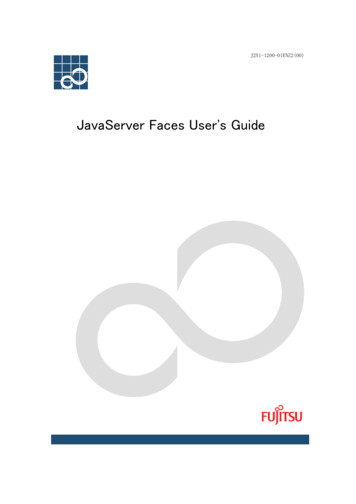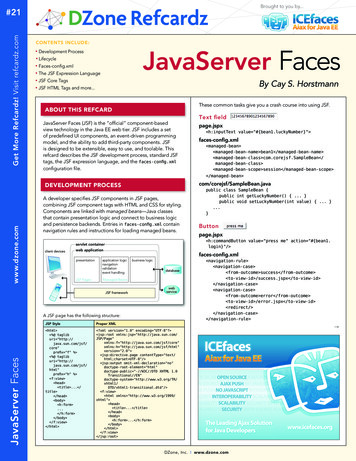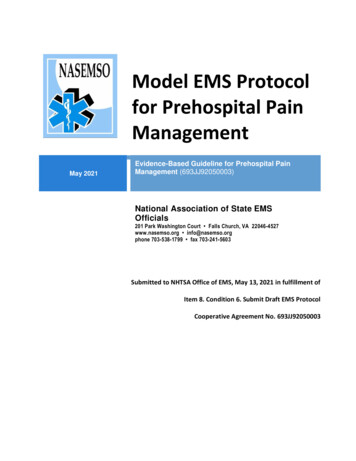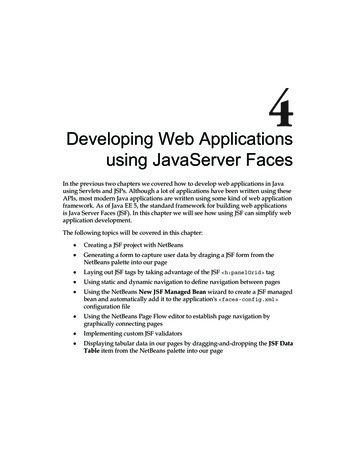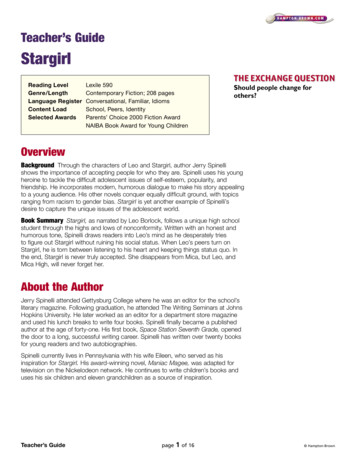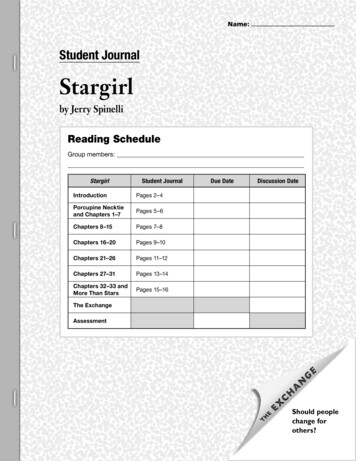
Transcription
ID2212, Network Programming with JavaLecture 11JavaServer Faces (JSF)JavaServer Pages (JSP)Leif LindbäckKTH/ICT/SCSHT 2016
Content Overview of JSF and JSPJSF IntroductionJSF tagsManaged BeansExpression languageJSP Standard Tag Library (JSTL)JSF Navigation and validationJSP OverviewLecture 11: JavaServer Faces (JSF), JavaServer Pages(JSP)2
Design of a Java EE application This is covered in the exerciseLecture 11: JavaServer Faces (JSF), JavaServer Pages(JSP)3
Two Different View TechnologiesJavaServer Faces, JSF– Newer– Dynamic views– Handles non-functional requirements like navigation,validation, composite views and view templates.– XHTML pages with JSF-specific tags that are convertedto XHTML tags.– Handled by the JSF framework that run inside theServlet container.Lecture 11: JavaServer Faces (JSF), JavaServer Pages(JSP)4
Two Different View Technologies,Cont'd JavaServer Pages, JSP– Older, left mainly for backwards compatibility– Dynamic views– Does not handle non-functional requirements.– JSP pages with JSP-specific tags. The pages aretranslated into Servlets.– Handled by the Servlet container itself.Lecture 11: JavaServer Faces (JSF), JavaServer Pages(JSP)5
Why Use JSF Instead of Plain JSP Avoid writing infrastructure code for nonfunctional requirements like navigation, validation,composite views and view templates. Thoroughly tested and proven to work well. Lots of documentation, easy to get help. Not using a framework means writing new codewhich means introducing new bugs.Lecture 11: JavaServer Faces (JSF), JavaServer Pages(JSP)6
Why Use JSF Instead of Plain JSP?Cont'd Non-functional requirements are difficult to code. Callback style makes sure all calls to nonfunctional requirements code are made at the righttime.– Handled by the framework.Lecture 11: JavaServer Faces (JSF), JavaServer Pages(JSP)7
JavaServer Faces, JSFjavax.facesJSF Home /overview/index.htmlJSF tag library aserver-faces-2-2/vdldocs-facelets/toc.htmLecture 11: JavaServer Faces (JSF), JavaServer Pages(JSP)8
A Simple Example The example has two views.Lecture 11: JavaServer Faces (JSF), JavaServer Pages(JSP)9
A Simple Example, Cont'd The first JSF page, index.xhtml.Lecture 11: JavaServer Faces (JSF), JavaServer Pages(JSP)10
A Simple Example, Cont'd The second JSF page, welcome.xhtml.Lecture 11: JavaServer Faces (JSF), JavaServer Pages(JSP)11
A Simple Example, Cont'd The managed bean, User.java.Lecture 11: JavaServer Faces (JSF), JavaServer Pages(JSP)12
Overview of JSF Architecture JSF has a component based architecture– Treats view parts as UI components.– Maintains an internal component tree, it is organized asa Document Object Model (DOM), or a Java FX UI.– index.xhtml in the initial example has threecomponents. The first, a form, is the ancestor of theother two, a button and a text field.Lecture 11: JavaServer Faces (JSF), JavaServer Pages(JSP)13
Overview of JSF Architecture,Cont'd Each tag in a page has an internal associated taghandler class inside JSF.– The tag handler classes are organized according to thecomponent tree. The internal JSF classes handles translation of JSFtags to HTML tags, interpretation of Http requests,calls to managed beans etc.Lecture 11: JavaServer Faces (JSF), JavaServer Pages(JSP)14
The Phases of a JSF RequestLecture 11: JavaServer Faces (JSF), JavaServer Pages(JSP)15
The Phases of a JSF Request Restore View Phase– Retrieves the component tree (i.e. tree of internal taghandler classes) for the page if it was displayedpreviously. It the page is displayed the first time thecomponent tree is instead created.– If there are no Http parameters in the request JSF skipsdirectly to the Render Response phase.Lecture 11: JavaServer Faces (JSF), JavaServer Pages(JSP)16
The Phases of a JSF Request, Cont'd Apply Request Values Phase– The Http request parameters are placed in a hash tablethat is passed to all objects in the component tree.– Each object identifies the parameters belonging to thecomponent it represents and stores those parametervalues.– Values stored in objects in the component tree are calledlocal values.Lecture 11: JavaServer Faces (JSF), JavaServer Pages(JSP)17
The Phases of a JSF Request, Cont'd Process Validations Phase– It is possible to attach validators to user editable components(typically text fields) in a JSF page, using JSF tags.– Example of validators are that a field is not empty, that aparameter is an integer, that it is a string of a certain lengthetc.– In this phase, the validators are executed to check that thelocal values are correct.– If some validation fails JSF skips to the Render Responsephase and redisplays the current page with error messagesabout the failed validations.Lecture 11: JavaServer Faces (JSF), JavaServer Pages(JSP)18
The Phases of a JSF Request, Cont'd Update Model Values Phase– The local values are used to update managed beans byinvoking setter methods.– Managed beans and their properties are identified bytheir names.– In the index.html page in the initial example theuser enters their name in a text field that has the valueuser.name.– This means the name is sent to the method setName inthe managed bean that is named user.Lecture 11: JavaServer Faces (JSF), JavaServer Pages(JSP)19
The Phases of a JSF Request, Cont'd Invoke Application Phase– Here the method specified by the action attribute ofthe component that caused the Http request is called.Lecture 11: JavaServer Faces (JSF), JavaServer Pages(JSP)20
The Phases of a JSF Request, Cont'd Render Response Phase– Here the next view is created.– Everything in the XHTML page except JSF tags isunchanged.– JSF tags are transformed to XHTML tags by the objects inthe component tree.– Getter methods in managed beans are called in order toretrieve values. In the welcome.xhtml page in the initialexample the value user.name is retrieved by a call to themethod getName in the managed bean that is named user.Lecture 11: JavaServer Faces (JSF), JavaServer Pages(JSP)21
Tag Libraries in JSF JSF tag library documentation is found -2-2/vdldocs-facelets/toc.htm HTML– Used to create HTML elements.– The recommended prefix is h:– Some important tags are covered below.Lecture 11: JavaServer Faces (JSF), JavaServer Pages(JSP)22
Tag Libraries in JSF Core– Used to add objects , such as validators, listeners andAJAX support, to HTML elements.– The recommended prefix is f:– Example in the slides explaining validation.Lecture 11: JavaServer Faces (JSF), JavaServer Pages(JSP)23
Tag Libraries in JSF, Cont'd Facelets– Used to create composite views, e.g. views that havecommon components like header, footer and menu,without using duplicated code.– The recommended prefix is ui:– Not covered in this course.Lecture 11: JavaServer Faces (JSF), JavaServer Pages(JSP)24
Tag Libraries in JSF, Cont'd Composite Components– Used to create custom components.– The recommended prefix is composite:– Not covered in this course.Lecture 11: JavaServer Faces (JSF), JavaServer Pages(JSP)25
Tag Libraries in JSF, Cont'd JSTL (JSP Standard Tag Library) Core– Utility tags managing for example flow control.– The recommended prefix is c:– Some important tags are covered below. JSTL (JSP Standard Tag Library) Functions– Utility functions mainly for handling strings.– The recommended prefix is fn:– Some example tags are covered below.Lecture 11: JavaServer Faces (JSF), JavaServer Pages(JSP)26
Tag Library Declaration Tag libraries must be declared in the XHTML pagewhere they are used. This is done in the HTML tag. The index.xhtml in the initial example usesthe HTML tag library. It is declared as follows. html xmlns "http://www.w3.org/1999/xhtml"xmlns:h "http://java.sun.com/jsf/html" Lecture 11: JavaServer Faces (JSF), JavaServer Pages(JSP)27
Some Tags in the HTML Tag Library head, renders the head of the page. body, renders the body of the page. form, renders an HTML form. inputText, renders an HTML text field. inputSecret, renders an HTML password field. outputLabel, renders a plain text label for anothercomponent. outputText, renders plain text. commandButton, renders a submit button.Lecture 11: JavaServer Faces (JSF), JavaServer Pages(JSP)28
Attributes for The HTML Tags All tags mentioned on the preceding page, excepthead and body, have the following attributes.– id, gives a unique name to the component. All componentshave a unique name. It is assigned by JSF if not statedexplicitly with the id tag.– value, specifies the component's currently displayed value.This can be an expression that refers to a property in amanaged bean. If so, the value will be read from the beanwhen the component is displayed and stored to the beanwhen the component is submitted.– rendered, a boolean expression that tells whether thecomponent is displayed or not.Lecture 11: JavaServer Faces (JSF), JavaServer Pages(JSP)29
Attributes for The HTML Tags,Cont'd The outputLabel tag also has the forattribute. Specifies for which other component this component isa label. The label is normally displayed immediately tothe left of that other component.Lecture 11: JavaServer Faces (JSF), JavaServer Pages(JSP)30
Attributes for The HTML Tags,Cont'd The commandButton tag also has the actionattribute. Tells what to do when the user clicks the button. Can be the name of a XHTML page, without the.xhtml extension. In this case the specified page isdisplayed. Can also be the name of a method in a managed bean,in this case that method is invoked.Lecture 11: JavaServer Faces (JSF), JavaServer Pages(JSP)31
Plain HTML Tags Instead of HTMLTag Library It Is allowed to use plain html tags instead of the HTMLtag library and the h: prefix. In this case, tags that shall be managed by JSF must haveattributes in the http://xmlns.jcp.org/jsfnamespace. The following slide illustrates this for the HTML5datalist tag, which has no corresponding tag in the JSFHTML tag library.32
Plain HTML Tags Instead of HTMLTag Library ?xml version '1.0' encoding 'UTF-8' ? !DOCTYPE html PUBLIC "-//W3C//DTD XHTML 1.0 xhtml1-transitional.dtd" html xmlns "http://www.w3.org/1999/xhtml"xmlns:jsf "http://xmlns.jcp.org/jsf" body form input list "browsers"/ datalist id "browsers" option value "Internet Explorer"/ option jsf:id "abc" value "#{data.browser}"/ /datalist /form /body /html 33
JSTL (JSP Standard Tag Library)Core Tags choose, an if statement. c:choose c:when test "#{condition}" The condition was true. /c:when c:otherwise The condition was false. /c:otherwise /c:choose If the boolean condition specified in the testattribute is true, the when block is executed, if notthe otherwise block is executed.Lecture 11: JavaServer Faces (JSF), JavaServer Pages(JSP)34
JSTL (JSP Standard Tag Library) CoreTags, Cont'd forEach, a loop statement. c:forEach var "element" items "#{myList}"varStatus "status" Element number #{status.count} is #{element} /c:forEach The var attribute specifies the name of the variable holding thecurrent element's value. This variable is used when the valueshall be displayed. The items attribute refers to the collection that shall be iteratedover. The varStatus attribute defines a variable that holdsinformation like the current element's index in the collection.Lecture 11: JavaServer Faces (JSF), JavaServer Pages(JSP)35
Functions In the JSTL (JSP StandardTag Library) Functions Library Note that these are functions, not tags. contains(str, substr), returns true ifstr contains substr. startsWith(str, substr, returns true ifstr starts with substr. length(str), returns the length of str. And many more.Lecture 11: JavaServer Faces (JSF), JavaServer Pages(JSP)36
JSTL (JSP Standard Tag Library), Cont'd Example:Lecture 11: JavaServer Faces (JSF), JavaServer Pages(JSP)37
Managed Beans Managed beans are plain Java classes.– Must have a public no-arg constructor.– Must have a scope annotation, e.g. @SessionScoped, see nextslide for more examples.– Annotated @Named(“myName”), where myName becomes thename of the bean. The beans are managed by the CDI (Context andDependency Injection) container.– Part of Java EE– Creates and connects objects according to specifications inannotations.– Powerful framework, but not covered in this course.Lecture 11: JavaServer Faces (JSF), JavaServer Pages(JSP)38
Managed Beans, Cont'd All managed beans have a scope which defines their life time.Some scope annotations are:– ApplicationScoped, the object will exist for the entireapplication life time.– SessionScoped, the object will be discarded when thecurrent Http session ends.– ConversationScoped, a conversation can be started andstopped manually in the code. If it is not, it has the life timeof a Http request. Unlike sessions, conversations are uniquefor each browser tab and therefore thread safe.– RequestScoped, the object will be discarded when thecurrent Http request is handled.Lecture 11: JavaServer Faces (JSF), JavaServer Pages(JSP)39
Managed Beans, ExampleLecture 11: JavaServer Faces (JSF), JavaServer Pages(JSP)40
Expression Language The expression language is used in dynamicexpressions in JSF (and JSP) pages.– Stateless, variables can not be declared.– Statements are written between #{ and }– The result of an EL statement is a string.Lecture 11: JavaServer Faces (JSF), JavaServer Pages(JSP)41
Expression Language, Cont'd The syntax is#{something.somethingElse}, wheresomething is for example one of the following:– The name of a managed bean.– param, which is a java.util.Map containing allHTTP request parameters. If there are more parameterswith the same name the first is returned.– paramValues, which is a java.util.Mapcontaining all HTTP request parameters. No matter howmany parameters there are with the specified name ajava.util.List with all of them is returned.Lecture 11: JavaServer Faces (JSF), JavaServer Pages(JSP)42
Expression Language, Cont'd– header, which is a java.util.Map containing allHTTP headers. If there are more headers with the samename the first is returned.– headerValues, which is a java.util.Mapcontaining all HTTP headers. No matter how manyheaders there are with the specified name ajava.util.List with all of them is returned.– cookie, which is a java.util.Map containing allHTTP cookies.Lecture 11: JavaServer Faces (JSF), JavaServer Pages(JSP)43
EL, The Operators . and [] If the operator . is used(#{something.somethingElse}) thefollowing must be true.– something is a java.util.Map or a managedbean.– somethingElse is a key in a java.util.Map ora property in a managed bean or a method in a managedbean.Lecture 11: JavaServer Faces (JSF), JavaServer Pages(JSP)44
EL, The Operators . and [], Cont'd If the operator [] is used(#{something[“somethingElse”]}) thefollowing must be true.– something is a java.util.Map, a managed bean,an array or a java.util.List.– If somethingElse is a string (surrounded by doublequotes, “”) it must be a key in a java.util.Map, aproperty in a managed bean, an index to an array or anindex to a java.util.List.– If somethingElse is not surrounded by doublequotes it must be a valid EL statement.Lecture 11: JavaServer Faces (JSF), JavaServer Pages(JSP)45
EL Examples If these are managed beans:@Named(“person”)public class PersonBean {@Inject private DogBean dog;public DogBean getDog() {return dog;}}@Named(“dog”)public class DogBean {private String name;public String getName() {return name;}} Then it is allowed to write #{person.dog.name} or#{person[dog["name"]]}.Lecture 11: JavaServer Faces (JSF), JavaServer Pages(JSP)46
EL Examples, Cont'd Input from an HTML form: form Address: input type "text" name "address" Phone1: input type "text" name "phone" Phone2: input type "text" name "phone" /form Can be read like this:The address is #{param.address}Phone1 is #{param.phone}Phone1 is #{paramValues.phone[0]}Phone2 is #{paramValues.phone[1]} However, there is seldom any need for this sincerequest parameters are normally handled by managedbeans.Lecture 11: JavaServer Faces (JSF), JavaServer Pages(JSP)47
The EL Operators Remember that JSF/JSP pages are views and thus not theplace for a lot of calculations. Arithmetic– addition: – subtraction: – multiplication: *– division: / or div– remainder: % or mod Logical– and: && or and– or: or or– not: ! or notLecture 11: JavaServer Faces (JSF), JavaServer Pages(JSP)48
The EL Operators, Cont'd Relational– equals: or eq– not equals: ! or ne– less than: or lt– greater than: or gt– less than or equal to: or le– greater than or equal to: or geLecture 11: JavaServer Faces (JSF), JavaServer Pages(JSP)49
EL, Null Values Since EL is used for user interfaces it produces themost user friendly output. This means that (like HTML) it tries to silently ignoreerrors. Null values does not generate any output at all, noerror messages are produced.Lecture 11: JavaServer Faces (JSF), JavaServer Pages(JSP)50
Navigation What calls should be made to the model and which isthe next view, provided the user has clicked YYY inview ZZZ. The next view may differ depending on the outcomeof the call to the model. Answers to the above should be stated as a set ofnavigation rules that are easy to change.–The value of the action attribute of the button or linkthe user invoked is called the outcome. The navigationhandling depends on the outcome.Lecture 11: JavaServer Faces (JSF), JavaServer Pages(JSP)51
Static Navigation If the outcome is the name of a XHTML page thenthat page is displayed.– This is called static navigation. The outcome is alwaysthe same.Lecture 11: JavaServer Faces (JSF), JavaServer Pages(JSP)52
Dynamic Navigation A user action can often have different outcomes,for example a login attempt might succeed or fail. In this case dynamic navigation must be used.Lecture 11: JavaServer Faces (JSF), JavaServer Pages(JSP)53
Dynamic Navigation, Cont'd Using dynamic navigation the value of the action attribute mustbe an expression identifying a method, for example#{loginManager.validateUser}, assuming that there isa managed bean named loginManager that has a methodcalled validateUser. The outcome will be the value that is returned by this method. Ifthe return value is not a String it will be converted to aString by calling its toString method. The outcome could be the name of a XHTML page, just likewith static navigation. If so this page will be displayed.Lecture 11: JavaServer Faces (JSF), JavaServer Pages(JSP)54
Dynamic Navigation, Cont'd It is not a good design that methods in the modelknows names of XHTML files. Therefore we want to have the action handlingmethod return a logical view name that is mappedto a XHTML file name.Lecture 11: JavaServer Faces (JSF), JavaServer Pages(JSP)55
Dynamic Navigation, Cont'd This is achieved by adding a navigation rule to the facesconfig.xml file navigation-rule from-view-id /login.xhtml /from-view-id navigation-case from-outcome success /from-outcome to-view-id /welcome.xhtml /to-view-id /navigation-case navigation-case from-outcome failure /from-outcome to-view-id /login.xhtml /to-view-id /navigation-case /navigation-rule The above means that if an action handling method specified on thelogin.xhtml page returns success the welcome.xhtml pageis displayed next. If on the other hand the method returns failurethe login.xhtml page is displayed again.Lecture 11: JavaServer Faces (JSF), JavaServer Pages(JSP)56
Dynamic Navigation, Cont'd Even though the action handling method now returns alogical outcome, one could argue that we still havesome amount of mixture of business logic and viewhandling. Consider for example a method withdraw in a bankapplication. Such a method would normally be void,but would now instead have to return the Stringsuccess only to indicate to JSF that the withdrawalwas successful.Lecture 11: JavaServer Faces (JSF), JavaServer Pages(JSP)57
Dynamic Navigation, Cont'd To avoid this problem we can let the withdrawmethod remain void, and instead add anothermethod, success, that returns true only if the lasttransaction was successful. faces-config.xmlwould then look as follows. navigation-rule from-view-id /withdraw.xhtml /from-view-id navigation-case if #{bankManager.success} /if to-view-id /success.xhtml /to-view-id /navigation-case /navigation-rule Lecture 11: JavaServer Faces (JSF), JavaServer Pages(JSP)58
No Matching Navigation Case If there is an outcome that does not correspond toa XHTML file and that has no matchingnavigation case, the last page is displayed again.Lecture 11: JavaServer Faces (JSF), JavaServer Pages(JSP)59
Validation Check data entered by the user. If validation fails the same view is shown againtogether with an error message. Which validations are to be made on what andwhich error messages to show if they fail isspecified by attaching validators to user inputcomponents.Lecture 11: JavaServer Faces (JSF), JavaServer Pages(JSP)60
Validation, Cont'd Validation concerns only checks that can be donewithout understanding the meaning of the input.The check should not include business logic.– For example that a field is not empty, that it contains aninteger or that it is an email address. Since some validation checks, like thosementioned above, occur frequently they arepredefined in JSF.Lecture 11: JavaServer Faces (JSF), JavaServer Pages(JSP)61
Validation Example h:inputText id "name" label "Name" value "#{user.name}" f:validateRequired/ /h:inputText h:message for "name"/ The validateRequired tag checks that the textfield is not empty. The message tag displays the error message if thevalidation failed. It is possible to customize the error message, but thatis outside this course.Lecture 11: JavaServer Faces (JSF), JavaServer Pages(JSP)62
Composite Views Views often consist of several parts like header, footer,navigation menus, main content etc. Many of these parts are common for different views. In order to avoid duplicated code it must be possible toreuse both page fragments (html) and page layout (divtags, css). Handled by the facelets tag library, but not covered inthis course.Lecture 11: JavaServer Faces (JSF), JavaServer Pages(JSP)63
Internationalization (i18n) andlocalization (l10n) Internationalization means to make it possible toswitch language. To add the possibility to show theuser interface in a new language should only require towrite the words in the new language, not anyadditional coding. Localization means to add support for a new language. Handled by the JSF core tag library, but not covered inthis course.Lecture 11: JavaServer Faces (JSF), JavaServer Pages(JSP)64
JSP: JavaServer Pagesjavax.servlet.jspJSP Home /tech/index.htmlLecture 11: JavaServer Faces (JSF), JavaServer Pages(JSP)65
What Is JSP? Framework used before JSF. A JSP page is written in HTML and translated to aServlet by the Servlet container. Dynamically-generated web content. Does not handle non-functional requirements likenavigation and validation.Lecture 11: JavaServer Faces (JSF), JavaServer Pages(JSP)66
The Life Cycle of a JSP At the first call:– The container translates the JSP to a servlet (translationtime)– The container compiles the servlet (compile time)– The container instantiates the servlet the same way itinstantiates any servlet.– The container calls jspInit().Lecture 11: JavaServer Faces (JSF), JavaServer Pages(JSP)67
The Life Cycle of a JSP, Cont'd At all calls:– The container calls jspService() of the servlet that wasgenerated at the first call (request time). If the JSP is unloaded from the container:– The container calls jspDestroy().Lecture 11: JavaServer Faces (JSF), JavaServer Pages(JSP)68
A Translated JSP The JSP: html head title Hello World! /title /head body h1 Hello World! /h1 /body /html Lecture 11: JavaServer Faces (JSF), JavaServer Pages(JSP)69
A Translated JSP, Cont'd The generated servlet (Tomcat 5.5.15):package org.apache.jsp;import javax.servlet.*;import javax.servlet.http.*;import javax.servlet.jsp.*;public final class hw jsp extends org.apache.jasper.runtime.HttpJspBaseimplements org.apache.jasper.runtime.JspSourceDependent {private static java.util.List jspx dependants;public Object getDependants() {return jspx dependants;}public void jspService(HttpServletRequest request,HttpServletResponse response)throws java.io.IOException, ServletException { The JSP's response is generated inLecture 11: JavaServer Faces (JSF), JavaServer Pages(JSP)jspService()70
A Translated JSP, Cont'd The generated servlet (cont):JspFactory jspxFactory null;PageContext pageContext null;HttpSession session null;ServletContext application null;ServletConfig config null;JspWriter out null;Object page this;JspWriter jspx out null;PageContext jspx page context null;try {jspxFactory Type("text/html");pageContext jspxFactory.getPageContext(this, request, response,null, true, 8192, true);jspx page context pageContext;application pageContext.getServletContext();config pageContext.getServletConfig();session pageContext.getSession();out pageContext.getOut();jspx out out;Lecture 11: JavaServer Faces (JSF), JavaServer Pages(JSP)71
A Translated JSP, Cont'd The generated servlet (cont):out.write(" html \n");out.write(" head \n");out.write(" title Hello World! /title \n");out.write(" /head \n");out.write("\n");out.write(" body \n");out.write(" h1 Hello World! /h1 \n");out.write(" /body \n");out.write(" /html \n");out.write("\n");} catch (Throwable t) {if (!(t instanceof SkipPageException)){out jspx out;if (out ! null && out.getBufferSize() ! 0)out.clearBuffer();if ( jspx page context ! null) jspx page context.handlePageException(t);}} finally {if ( jspxFactory ! null) jspxFactory.releasePageContext( jspx page context);}}} The response is sent.Lecture 11: JavaServer Faces (JSF), JavaServer Pages(JSP)72
Actions and Directives A directive is an instruction to the container aboutthe translation of a JSP.– Does not exist in the translated Java code.– There are three directives: page, taglib and include.– Written between %@ and % (for example %@page . % ).Lecture 11: JavaServer Faces (JSF), JavaServer Pages(JSP)74
Actions and Directives, Cont'd An action is translated into Java code and executedat request time.– Syntax: prefix:action name/ – Standard actions are defined in the specification andhave the prefix jsp.– Custom tags are defined by the developer and may haveany prefix (except reserved prefixes like jsp).Lecture 11: JavaServer Faces (JSF), JavaServer Pages(JSP)75
To Include Other Files The include directive:– %@include file "header.jsp"% – The directive is replaced with the content of thespecified file (header.jsp) at translation time.– Both static (for example HTML files) and dynamiccontent (for example other JSP files) can be included.– The path to the included file is specified relative to thefile with the include directive.Lecture 11: JavaServer Faces (JSF), JavaServer Pages(JSP)76
To Include Other Files, Cont'd The jsp:include standard action:– Syntax: jsp:include page "header.jsp"/ – The included page is translated to a servlet that is called(that is, its jspService() method is called) by theincluding servlet at request time.– Only JSPs can be included.– The output of the included Servlet is inserted in theoutput of the including Servlet.– The path to the included page is a URL. It is eitherrelative to the URL of the including page or absolutestarting with the context root of the web application.Lecture 11: JavaServer Faces (JSF), JavaServer Pages(JSP)77
To Include Other Files, Cont'd It is possible to pass parameters to the includedpage if the jsp:include action is used.– The following code should be placed in the includingpage: jsp:include page "header.jsp" jsp:param name subTitle" value "A dynamic subtitle"/ /jsp:include – The parameter subTitle will be available as anHTTP request parameter in the included page.– It can be output like this: h3 {param.subTitle} /h3 Lecture 11: JavaServer Faces (JSF), JavaServer Pages(JSP)78
Error handling It is possible to define error pages. If an exceptionoccurs in a JSP (or servlet) the container forwards thecall to the error page.– Error pages are defined like this in the deploymentdescriptor: !-- An error page for a Java exception. The call isforwarded to the error page if the specified exception or asubclass of it is thrown. -- error-page exception-type java.lang.Throwable /exception-type location /errorpage.jsp /location /error-page !-- An error page for an HTTP error -- error-page error-code 404 /error-code location /errorpage.jsp /location /error-page Lecture 11: JavaServer Faces (JSF), JavaServer Pages(JSP)79
Error handling, Cont'd An example of an error page: %@ page isErrorPage "true" % html head title This page handles exceptions /title /head body h1 This page handles exceptions /h1 p An {pageContext.exception} was thrown. Its message was: {pageContext.exception.message} /p /body /html This must always be written in an error page. This is the exception object that was thrown.Lecture 11: JavaServer Faces (JSF), JavaServer Pages(JSP)80
NEVER EVER Write Java code in aJSP There are ways to insert Java code directly in aJSP.– Possible only for backwards compatibility NEVER EVER do that!– Gives high coupling and low cohesion.– Makes the code inflexible, difficult to understand andhard to maintain.– Forces
Lecture 11: JavaServer Faces (JSF), JavaServer Pages (JSP) 6 Why Use JSF Instead of Plain JSP Avoid writing infrastructure code for non-functional requirements like navigation, validation, composite views and view templates. Thoroughly tested and proven to work well. Lots of documentation, easy to get help.
